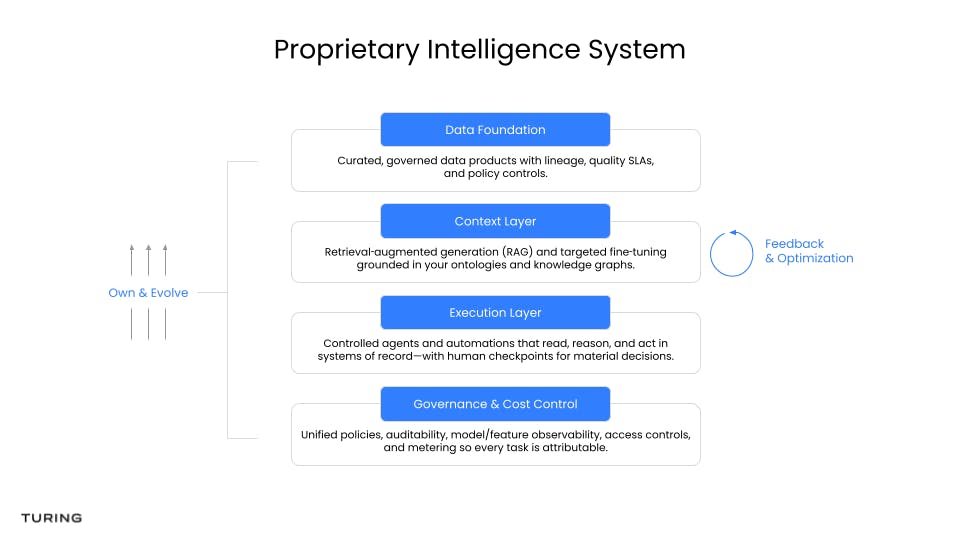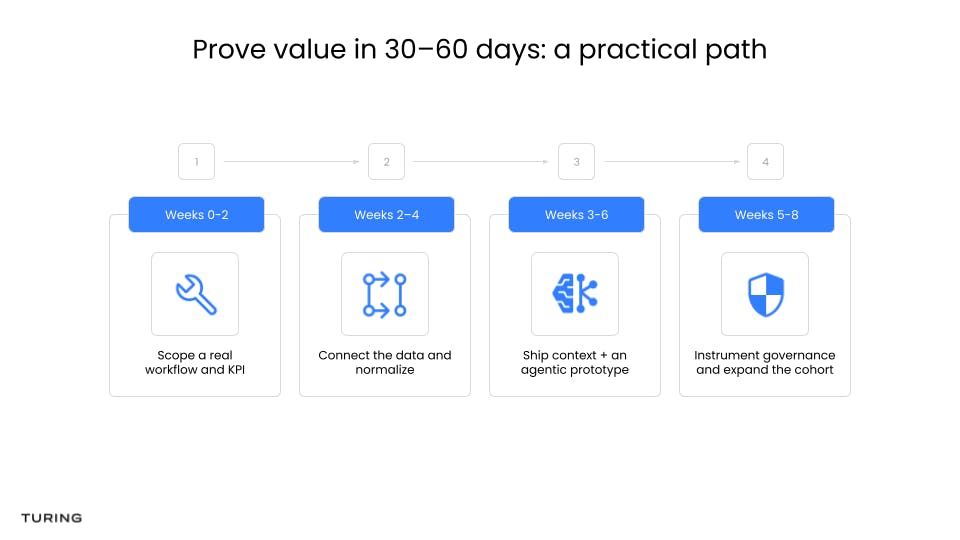After two intense years of experimentation, most enterprises are discovering that models alone don’t create advantage. Advantage comes from a proprietary intelligence system: your data foundation, your context and semantics, your agentic execution, and your governance—stitched together and operated with human oversight.
The path forward is pragmatic: pick one workflow, prove value in 30–60 days, then scale deliberately. And once you’ve proven one, momentum builds quickly—one workflow becomes dozens, and soon you’re running a true AI system woven across the enterprise.
What a proprietary intelligence system is (and is not)
A proprietary intelligence system is the operational core of your company’s AI. It’s not a single model or vendor—it’s a layered system you own and evolve.

- Data foundation: Curated, governed data products with lineage, quality SLAs, and policy controls.
- Context layer: Retrieval‑augmented generation (RAG) and targeted fine‑tuning grounded in your ontologies and knowledge graphs.
- Execution layer: Controlled agents and automations that read, reason, and act in systems of record—with human checkpoints for material decisions.
- Governance & cost control: Unified policies, auditability, model/feature observability, access controls, and metering so every task is attributable.
Treat base models as replaceable components inside this system. The ecosystem shifts quickly; design abstractions that let you swap or multi‑model without rebuilding the house.
The minimum viable system
Start with a governed data foundation
Inventory the data required for one high‑value workflow, define access patterns, and establish privacy, security, and retention rules up front. Nothing works without reliable inputs.
Build the enterprise context layer
Ground model outputs in your private knowledge with RAG. Where RAG cannot hit accuracy/latency targets, pursue targeted fine‑tuning—but keep abstractions so you can migrate or multi‑model later.
Encode your domain semantics
Your business runs on concepts—products, customers, claims, SKUs, policies. Capture them in a living ontology/knowledge graph and expose the relationships to models and agents.
Orchestrate decisions and actions with guardrails
Design agents to complete bounded tasks (triage a claim, draft a response, reconcile a record) and route edge cases to humans. Capture rationales and evidence for every action.
Unify governance, observability, and cost discipline
Instrument inputs, prompts, outputs, evaluations, and human feedback. Track unit costs per task and per outcome. Create auditable trails that satisfy internal risk and external regulators.
Prove value in 30–60 days: a practical path

Weeks 0–2 — Scope a real workflow and KPI
Pick a mandatory, high‑volume process (e.g., KYC refresh, invoice reconciliation, customer email triage). Tie it to a measurable KPI like handle time, accuracy, or loss rate.
Weeks 2–4 — Connect the data and normalize
Wire only the data you need right now. Normalize schemas, redact PII as required, and write simple data contracts to prevent downstream changes from breaking the flow.
Weeks 3–6 — Ship context + an agentic prototype
Stand up RAG over your curated corpus and ship a narrow agent that acts in sandboxed systems. Require human approval for mid‑confidence outputs; autoprocess only the obvious cases.
Weeks 5–8 — Instrument governance and expand the cohort
Add evaluation sets, hallucination checks, and cost meters. If metrics hold, expand to the next segment (more users, more documents, more channels).
What will proprietary intelligence look like 12 months from now?
Enterprises that move beyond generic tools to proprietary intelligence will operate at a new cadence: prototypes in days, decisions with evidence, and automation that expands only where the data proves it. The question isn’t whether to build this system—it’s which workflow you’ll transform first.
Talk to a Turing Strategist to map a 30–60 day plan from generic AI to proprietary intelligence in your environment.

James Raybould
Want to accelerate your business with AI?
Talk to one of our solutions architects and start innovating with AI-powered talent.



